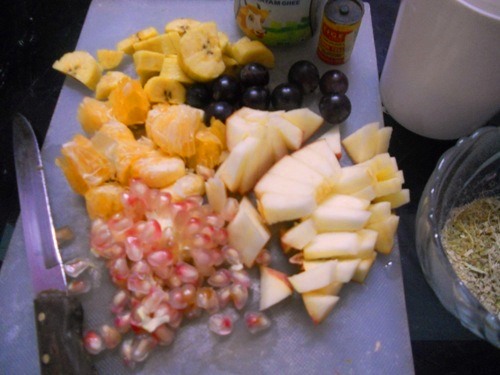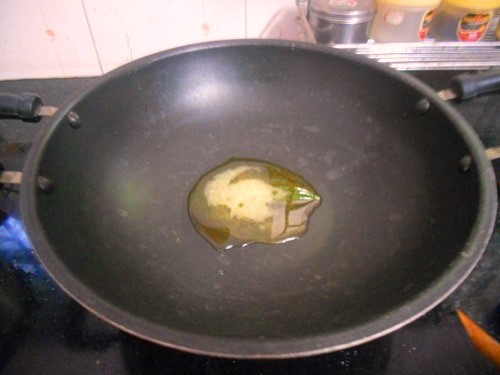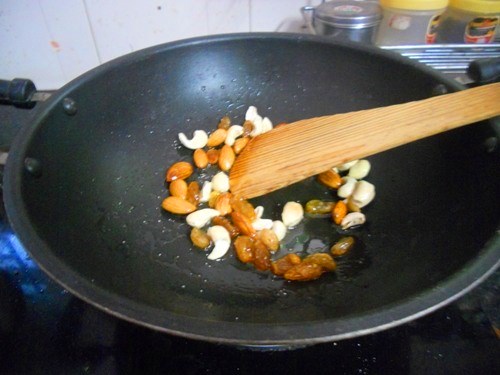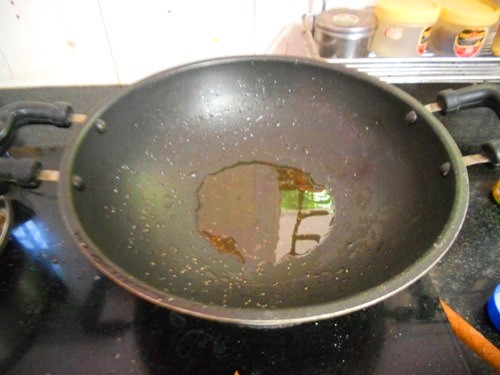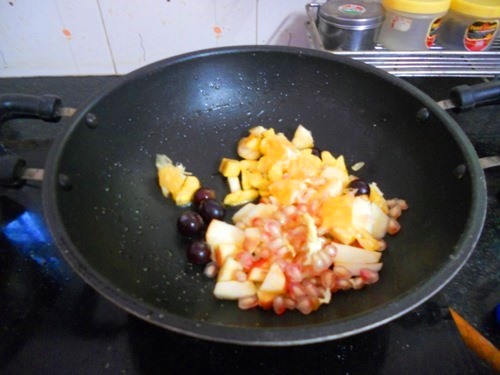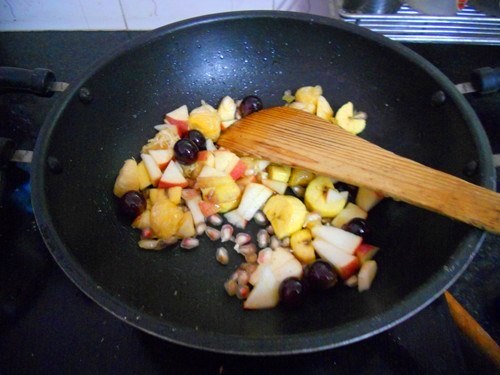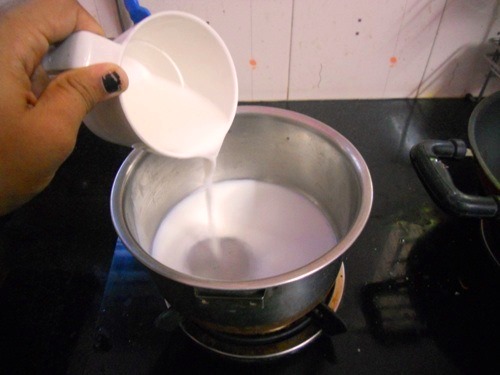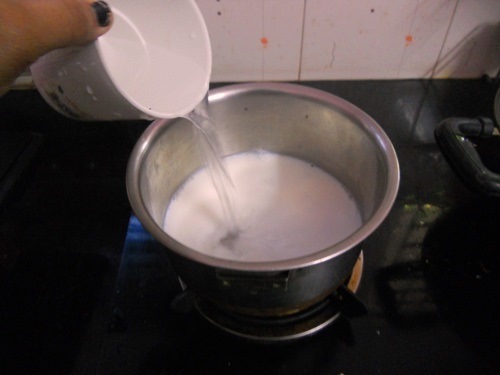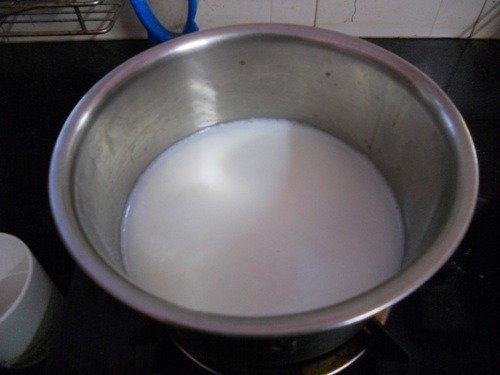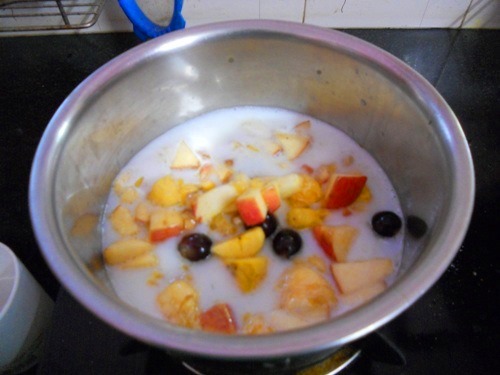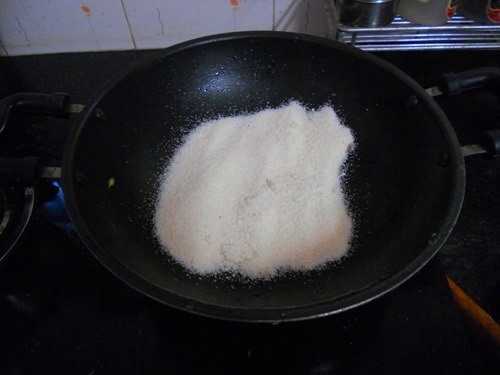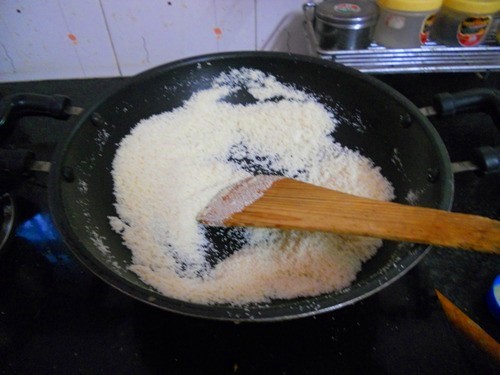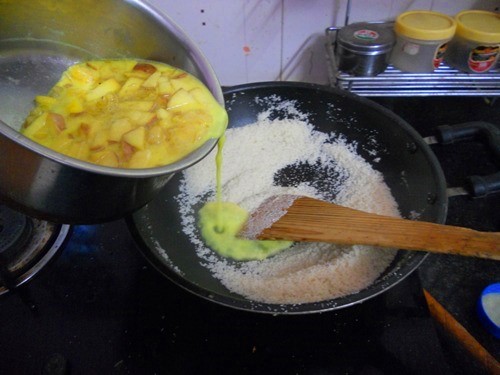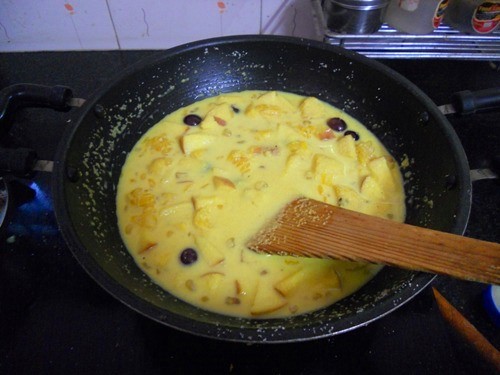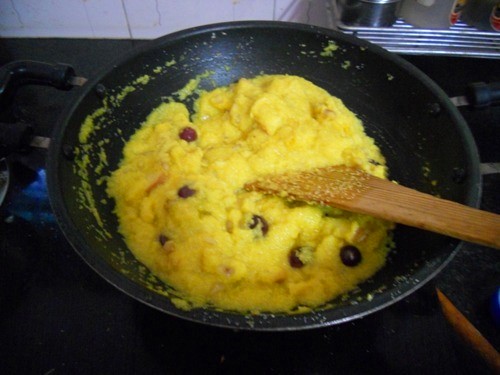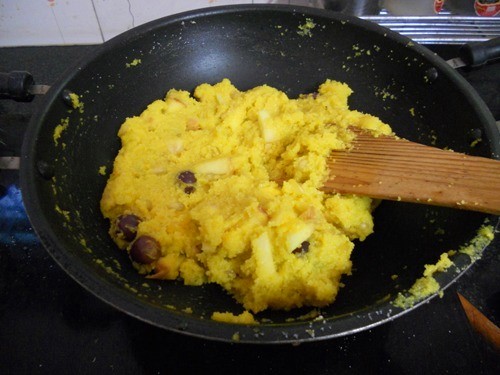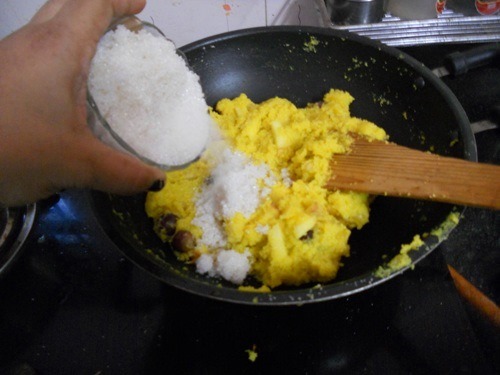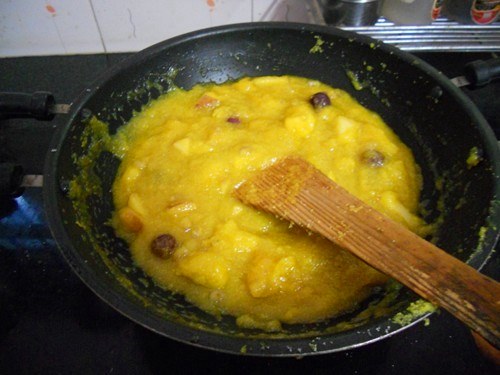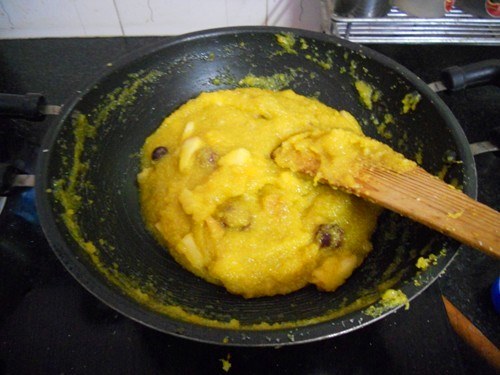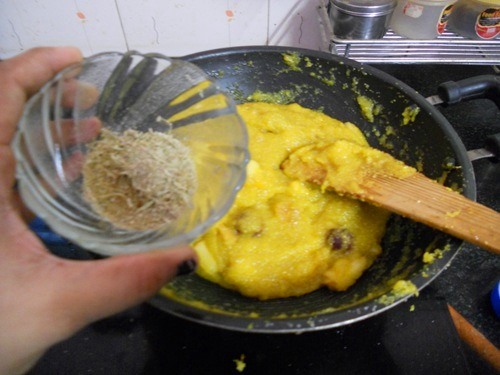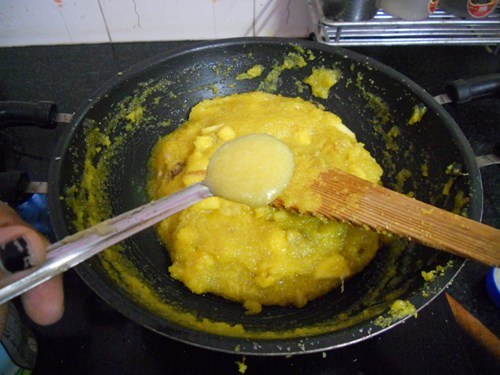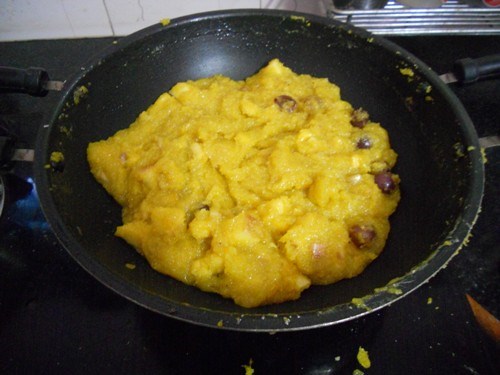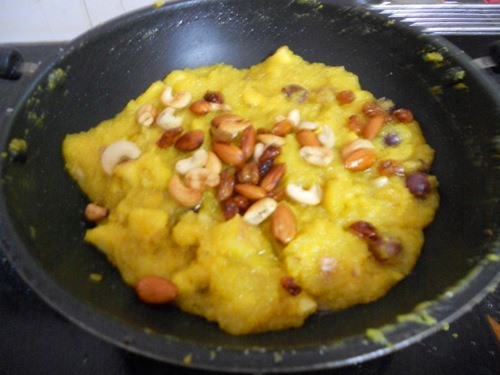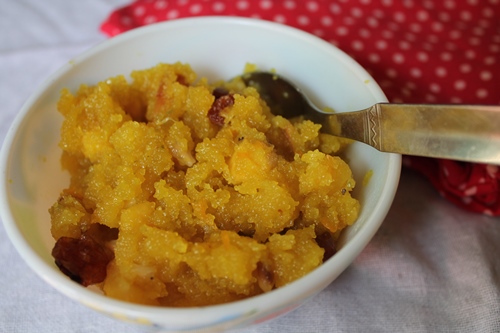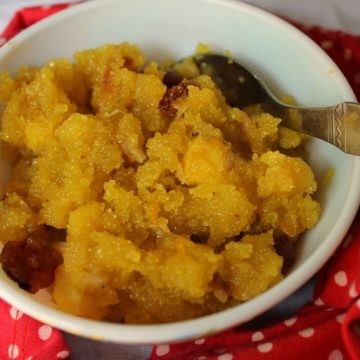What is Fruit Kesari? Fruit Kesari is a sweet South Indian dessert made using rava (sooji or semolina), cooked with milk and water, and flavored with ghee, cardamom, and most importantly – a mix of fresh fruits and nuts. It’s a twist on the traditional kesari, which usually sticks to plain rava and sugar. In this version, fruits like apple, banana, grapes, orange, and pomegranate are gently sautéed and then added into the kesari to give a soft bite, flavor, and a beautiful look. It’s commonly made during Diwali or special occasions, but honestly, I feel it’s a wonderful pick even for casual family get-togethers or when you want to serve something different for dessert.


Fruits Kesari Recipe
You all know my love for kesari, I have quite a few variation in my blog starting from the basic rava kesari, semiya kesari to the rich milk kesari. This is another version of my pineapple kesari, it has a lots of mixed fruits and nuts in them. It taste simply delicious. Great for parties. So give this a try and let me know how it turns out for you.
Jump to:
About Fruit Kesari
This recipe is a fruity twist on the classic South Indian Rava Kesari or Sooji Sheera. It’s similar to pineapple kesari but made even better with a mix of fruits like apples, bananas, oranges, grapes, and pomegranate. The roasted rava base stays soft and grainy, while the fruits add juicy bursts in every bite. It’s sweet, warm, and full of flavor from ghee and cardamom.
I usually prepare this when there are leftover fruits lying around. Slightly soft grapes or overripe bananas work really well. The fruits are lightly sautéed in ghee, which brings out their flavor, then boiled with milk and water to blend smoothly with the kesari. Roasted cashews, almonds, and raisins add a lovely crunch and traditional richness.
It also looks beautiful bright yellow with colorful fruit peeking through, making it perfect for parties or festive meals. It’s a fun way to make kids eat fruits too! You can put this together in under 40 minutes with just pantry staples and seasonal fruits.
Similar Recipes
Rava Kesari
Semiya Kesari
Poha Kesari
Milk Kesari
Fruit Kesari
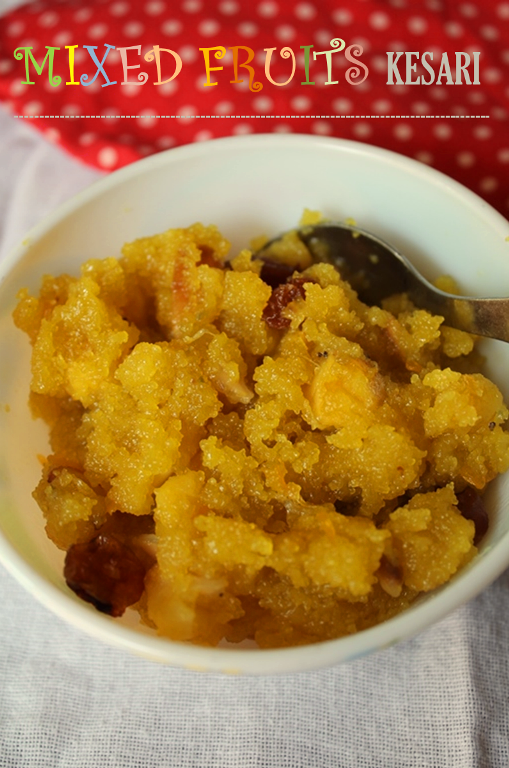

Why This Recipe Works
This recipe stands out because of the mix of milk and water, which gives the kesari a richer taste and smoother texture than using just water. It feels festive without being too heavy. The fruits are lightly sautéed in ghee first, which softens them and brings out their sweetness. This way, they blend in well and don’t feel raw or sour when you bite into them.
Why I Like This Recipe – This is one of my favorite go-to recipes when I want something quick, tasty, and a little special. It uses simple ingredients like rava, ghee, and sugar things already in the pantry. What I love most is how flexible it is. You don’t need a fixed list of fruits whatever is lying around will do. Even just banana or apple works fine, so nothing goes to waste. It’s also a hit with family, especially kids. The bright color and sweet taste make it appealing, and it’s a clever way to get them to eat fruits without complaints. Lastly, it reminds me of the kesari served at functions growing up—but with a fruity twist. It feels nostalgic and new at the same time, which makes it even more special.
Boiling the fruits with the milk mixture allows their flavors to slowly infuse into the base, so the kesari feels naturally fruity rather than just having fruit bits tossed in at the end. Finally, the sugar and ghee are balanced just right. It’s sweet and aromatic, but not too greasy or sugary making it satisfying without being overwhelming.
Ingredients
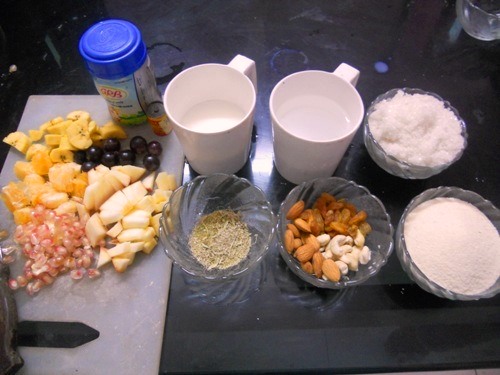

Rava (Sooji) – This is the main base of the kesari. I use fine rava (semolina), which cooks quickly and gives that soft, slightly grainy texture that makes kesari so comforting.
Sugar – This amount gives the right level of sweetness for a festive dish. If your fruits are very sweet (like ripe bananas or juicy grapes), you can reduce it a little based on your taste.
Milk and Water – This 50-50 mix makes a big difference. Milk adds a subtle richness while water keeps it light. Together, they help the rava cook smoothly and give a creamier texture than water alone.
Ghee – Used in parts for roasting nuts, sautéing fruits, and adding at the end for that glossy finish. Ghee adds flavor, helps with texture, and makes the dish more aromatic.
Mixed Fruits – I usually use a small mix of apple, banana, orange, grapes, and pomegranate. All are chopped into small pieces so they blend well. Use whatever fruits you have just make sure they’re fresh and ripe.
Cashews & Almonds – Sliced or broken into bits and fried in ghee. They add crunch, richness, and a little bite in each spoonful.
Kishmish (Raisins) – Once roasted in ghee, they puff up and turn soft and sweet. These tiny bites balance the texture and give mild sweetness naturally.
Cardamom Powder – Just a pinch adds a lovely aroma and a warm flavor that feels familiar in most Indian sweets.
Yellow Food Color – This gives the kesari its signature golden color, but it’s completely optional. You can skip it if you prefer a more natural look.


Hacks
Use ripe bananas – Ripe or even slightly overripe bananas are perfect for this dish. They’re naturally sweet and soft, which means they blend right into the kesari without leaving chunks behind. Plus, they add a gentle banana flavor that works really well with the other fruits.
Roast the rava on low heat – This step is important for the texture. If you roast the rava slowly and patiently on a low flame, it becomes aromatic and slightly nutty. It also helps prevent lumps when you add the liquid, giving you a smooth and fluffy kesari.
Add a pinch of salt – It may seem like a small thing, but a little salt can really balance the overall taste. It cuts through the sweetness just enough to make the flavors more rounded and less flat. Try it—you’ll notice the difference.
Don’t skip the cardamom powder – Cardamom adds that special aroma that makes Indian desserts feel complete. Even a small pinch lifts the entire dish and gives it a familiar, comforting flavor. If you can, use freshly crushed pods for an even stronger scent.
Fruit Kesari (Step by Step)
Expert Tips
Roast the rava properly – This is one step you really shouldn’t skip. Roasting the rava on a low flame helps bring out its flavor and also keeps it from turning sticky or clumpy. Even if you’re short on time, give it at least 2–3 minutes. A properly roasted rava makes all the difference.
Keep stirring after adding the milk – Once the milk and water mix goes into the rava, it tends to bubble up and cook quickly. Stirring it continuously at this stage helps prevent lumps from forming and keeps the texture smooth and creamy.
Serving Suggestions
Kesari tastes best when served warm or hot, so try to enjoy it fresh if you can. It goes really well as a breakfast or snack alongside light dishes like pongal or upma. You can also serve it as a sweet treat after lunch or dinner, it’s satisfying without being too heavy. A sprinkle of extra roasted nuts on top right before serving adds a nice crunch.
Storage
If you have any leftover kesari, store it in an airtight container in the fridge. It will stay good for up to 2 days. When you’re ready to eat it again, gently reheat it on the stove or in the microwave. Adding a splash of milk or water while reheating helps loosen it up, and a little extra ghee stirred in brings back the rich flavor and smooth texture.
FAQ
Q:Can I make this less sweet?
Yes, absolutely! You can easily reduce the amount of sugar by about a quarter to half a cup depending on how sweet your fruits are. If your fruits like banana or grapes are very ripe and naturally sweet, cutting back on sugar will help keep the kesari balanced. It’s easy to adjust based on your taste.
Q:Can I skip some fruits?
Definitely. This recipe is very flexible. You can use whatever fruits you have available or like the most. Even if you only have two or three types, it will still taste great. The fruit choice won’t affect the overall texture much.
Q: Can I make it vegan?
Yes, you can. Just replace the regular milk with coconut milk and use coconut oil instead of ghee. This way, the kesari stays creamy and flavorful without any animal products. It’s a great option for those avoiding dairy.
Q:Can I prepare this ahead of time?
Yes, you can make it ahead and store it in the fridge. When you’re ready to eat, gently reheat it with a little milk and ghee to bring back the soft texture and rich flavor. Just avoid overheating so it doesn’t dry out. This makes it convenient for busy days.
Variations
With Coconut: If you like the taste of coconut, add some grated fresh or desiccated coconut while sautéing the fruits. This adds a nice texture and a traditional flavor that pairs well with the kesari. It’s a subtle but tasty addition.
Only One Fruit: You can keep it simple by making kesari with just one fruit, like banana kesari or pineapple kesari. This is great when you want a quick version or only have one type of fruit on hand. It’s also a good way to highlight a favorite fruit.
Paneer Add-in: For a richer and more festive version, add small crumbled cubes of paneer towards the end of cooking. It gives a unique texture and makes the dessert feel more special. This can be a nice twist for celebrations.
Color Variations: Feel free to experiment with food colors for fun occasions—orange, pink, or yellow can brighten up the kesari and make it perfect for themed celebrations or festivals. It adds visual appeal without changing the taste much.
More Kesari Recipes to Try
📖 Recipe Card
Fruit Kesari Recipe
Servings: 4 servings
Calories: 663kcal
Instructions
Step 1: Prepping and Roasting – Begin by chopping all the fruits into small pieces so they cook quickly and mix well into the kesari. Measure out the milk, water, rava, sugar, ghee, and keep the nuts ready. In a thick-bottomed kadai, Heat a couple of tablespoons of ghee and fry the cashews, almonds, and raisins until golden. Once done, set them aside and lightly sauté the chopped fruits in extra 2 tbsp ghee for just a minute or two to soften them.
Step 2: Making the Flavored Milk and Cooking Rava – In a separate pan, heat 1 cup of milk and 1 cup of water, and add the sautéed fruits with a small pinch of yellow food color (optional). Bring it to a gentle boil so the fruity flavors infuse into the milk. In the same kadai, add a bit more ghee and roast the rava on low flame for a couple of minutes. Then slowly pour the hot milk-fruit mix into the roasted rava, stirring constantly to avoid lumps.
Step 3: Sweetening and Final Touches – Once the rava thickens and absorbs the liquid, stir in the sugar. The kesari loosens for a bit, but it thickens again with a few more minutes of cooking. Add in ghee little by little and cook. Add cardamom powder, a final spoon of ghee, and the fried nuts and raisins. After a gentle mix, turn off the heat leaving behind a warm, fruity kesari that’s ready to enjoy.
Nutrition
Serving: 1servings | Calories: 663kcal | Carbohydrates: 125g | Protein: 9g | Fat: 16g | Saturated Fat: 9g | Polyunsaturated Fat: 1g | Monounsaturated Fat: 5g | Cholesterol: 36mg | Sodium: 33mg | Potassium: 380mg | Fiber: 4g | Sugar: 89g | Vitamin A: 141IU | Vitamin C: 9mg | Calcium: 107mg | Iron: 2mg
If you have any questions not covered in this post and if you need help, leave me a comment or mail me @[email protected] and I’ll help as soon as I can.
Follow me on Instagram, Facebook,Pinterest ,Youtube and Twitter for more Yummy Tummy inspiration.
IF YOU MAKE THIS RECIPE OR ANYTHING FROM YUMMY TUMMY, MAKE SURE TO POST IT AND TAG ME SO I CAN SEE ALL OF YOUR CREATIONS!! #YUMMYTUMMYAARTHI AND @YUMMYTUMMYAARTHI ON INSTAGRAM!
More Sweets to Try
–>

